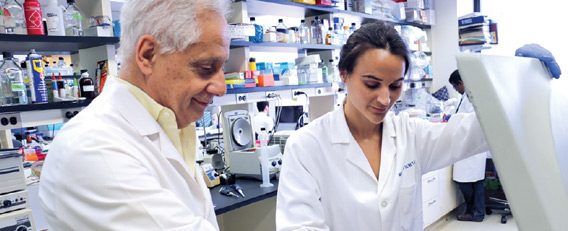Science Teachers Trade Summer Vacation to Conduct Research
When Samuel Silverstein, MD, the John C. Dalton Professor Emeritus of Physiology & Cellular Biophysics and former department chair, gave lectures to high school science students and their teachers in the 1980s, he noticed that “many teachers appeared to be unfamiliar with contemporary techniques in cell biology,” he says. That insight, and his concerns with the overall quality of science education in New York City schools, led him to found Columbia University’s Summer Research Program for Science Teachers, now in its 30th year.
The program provides paid fellowships for New York metropolitan area middle and high school science teachers, enabling them to participate in hands-on research in Columbia University and New York Stem Cell Foundation laboratories for eight weeks each year over two consecutive summers. Through a grant from NYSTEM, New York state’s stem cell initiative, the program currently focuses on stem cell biology.
The program was the first professional development program for science teachers to require two full summers of participation. Since the program’s beginning, 327 teachers have completed it, and 211 Columbia faculty members have mentored one or more teachers for two summers.
Kimberly Dempsey, one of 15 science teachers who participated in the program in the summer of 2018, spent the summer in Columbia Stem Cell Initiative Director Emmanuelle Passegué’s lab working with postdoctoral fellow Amélie Collins, MD, PhD, to develop a protocol for comparing hematopoietic stem cells from neonatal and adult mice.
“The most exciting part of the experience has been talking with Dr. Collins about her experimental design, listening to her think through her choices for controls, and her responses when unexpected data come back,” says Ms. Dempsey, a 10th grade chemistry teacher in Manhattan. “It is wonderful to witness the creativity and logic inherent in good scientific research.” She also has used what she has learned to modify her teaching. “I have been developing a list of important basic skills that I see done around me. A big one that I have not focused enough on is having students prepare dilutions from solutions and explain how these dilutions are made.”
Teachers also have benefited in other ways. Ronnie Almonte spent his first summer in the program conducting research on embryonic stem cells in the lab of Dieter Egli, PhD. “Columbia’s program bridges the gap between my local public school and all the city has to offer,” says Mr. Almonte. “I’m already starting to make connections. A postdoc in the lab said he would love to talk to kids in my classroom. When students meet real scientists, they get a better sense of what science is and, perhaps, their potential place in it.”
Program graduate Arlene Ramos, PhD, who teaches health in a Manhattan high school, learned about opportunities to enhance her teaching while conducting research on Alzheimer’s disease in the lab of Ottavio Arancio, MD, PhD. Dr. Ramos has been accepted into the Math for America and Columbia’s Zuckerman Institute Brain Insight Teacher Scholar programs.
A study published in Science magazine by Dr. Silverstein and colleagues from Columbia, New York University, and the University of Michigan reported that 10 percent more students of teachers who completed Columbia’s program passed New York Regents exams in biology, chemistry, and earth sciences than classmates studying the same subjects in classes taught by other teachers in the same school. The study also showed that program graduates stayed in education at a higher rate than comparably experienced teachers who did not participate, saving New York City’s Department of Education about $20,000 spent on each newly recruited teacher. Dr. Silverstein estimates that on average each program graduate saves the city’s Department of Education about $100,000 in the first four years following his/her entry into the program for courses students do not have to repeat, Regents exams they do not have to retake, and teachers who do not have to be replaced.
“One of my greatest pleasures in directing this program is seeing its teachers and their students succeed,” says Dr. Silverstein. The program, its teachers, and their students have earned 61 national, state, and local awards since 2003, including seven Alfred P. Sloan Foundation-Fund for the City of New York Awards for Excellence in Teaching Science and Mathematics, the highest honor given to city science and math teachers.
Impressed by the program’s results, other institutions have adopted its model, including Stanford University’s science outreach program, New York state’s Questar III BOCES, and New York state NYSTEM-sponsored initiatives at Cornell University and Rensselaer Polytechnic Institute. The experiences at other institutions have encouraged Dr. Silverstein to seek expansion of the summer research program concept. “There are only about 5,000 high school science teachers in New York City’s public high schools. We could provide these experiences for about 15 percent of them in 10 years if all New York City medical schools and science-rich universities joined together to implement programs like ours,” says Dr. Silverstein. He is collaborating with the Associated Medical Schools of New York to propose such an initiative to New York City’s Department of Education. “The more we collaborate to support teachers and their schools, the more likely their students will be prepared and interested in pursuing careers in medicine, health, and other humanly rewarding and remunerative STEM disciplines.”
Dr. Silverstein has received several awards for developing and directing Columbia’s Summer Research Program. Among them are the 2003 New York Mayor’s Award for Public Understanding of Science, the American Society for Cell Biology’s 2005 Bruce Alberts Award for Excellence in Education, and the 2017 Vagelos College of Physicians and Surgeons Award for Excellence in community service.
- Log in to post comments


